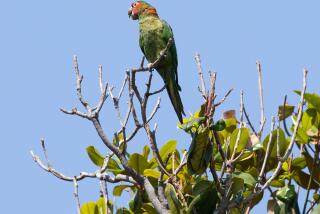India’s Homing Pigeons Dying of Neglect
- Share via
CUTTACK, India — For a half century, the sturdy, Belgian-bred birds of the Orissa Police Pigeon Service have braved hawks, wind and rain to carry messages during floods, famine and other disasters.
Now they are dying from neglect.
Twenty-one of the homing pigeons once praised by India’s first prime minister, Jawaharlal Nehru, have died of sunstroke in recent months, said B.N. Das, police superintendent of signals at the pigeon service headquarters.
In the understaffed and cash-strapped police department, the 34 constables assigned to pigeon duty in remote districts consider the job a punishment, he said. And the department’s 680 carrier pigeons are seen as costly anachronisms in an age of VHF radios and e-mail.
“The pigeon service made practical sense when we were superintendents of police two decades ago, as there were no VHF sets at that time,” Das said. “But now all police stations in Orissa are on the radio network, reducing the winged service to a museum piece.”
The homing pigeons live up to 20 years and are trained from the age of six weeks. Das said the powerfully built birds can fly up to 500 miles at a stretch at up to 55 miles per hour, depending on the weather.
In Orissa, on India’s eastern coast along the Bay of Bengal, the weather is often wet and windy. Cyclones and floods frequently cut off villages, and for years the police pigeons carried appeals for help and returned with messages of hope.
When floods devastated much of coastal Orissa in 1982, the police pigeons were the only method of communication because radio networks were disrupted by water.
The pigeons were not used in last year’s devastating super-cyclone, however. The disaster was so great that the constables assigned to the pigeon posts fled, Das said. The state’s communications system was useless for days, but word finally got out through ham radio operators.
Das said 10 pigeons died of heat stroke at the Puri station in April. In June, 11 died from the same cause at Cuttack. The pigeon service is headquartered in Cuttack, but only one constable was assigned to care for them.
Das said sunstroke is a common cause of death in pigeons that are not watched over. “Whoever is posted there considers it a punishment posting, with no other work but to look after the birds,” he said.
He said the police department has asked the government to sell off most of the birds and use the pigeon service’s $2,900 annual budget elsewhere in the department. Some birds would be kept in cages in a museum at Cuttack or displayed at parades.
“We want the present generation and visiting dignitaries to know the service these birds rendered, especially during natural calamities like floods and cyclones,” Das said.
The Orissa police started the Pigeon Service in 1946, borrowing trained birds from the army after World War II.
The birds were trained to specialize in three types of service: static, boomerang and mobile.
A static-trained bird flies one way, often for the longest distances, with a message attached to one of its legs. It is then returned to its home base.
Boomerang birds travel regularly, carrying messages between two points within a 60-mile radius.
Mobile pigeons fly back to their home base and are carried by police officers patrolling remote areas to keep in touch with their colleagues.
When Nehru came to Orissa on April 13, 1948, to inaugurate a dam, he praised the pigeons as “quite useful,” Das said.
From Sambalpur, Nehru sent a message to state officials in Cuttack by pigeon telling them that “the arrangements for the public meeting should not be such as to separate the speaker from the audience.”
When he arrived at Cuttack to give his speech, Nehru had taken six hours to travel the 125 miles by air and road. The pigeon made it in just over five hours.
More to Read
Sign up for Essential California
The most important California stories and recommendations in your inbox every morning.
You may occasionally receive promotional content from the Los Angeles Times.













